How Had I Never Seen..."The Wild One" (1953)?
 Wednesday, April 3, 2024 at 10:00PM
Wednesday, April 3, 2024 at 10:00PM 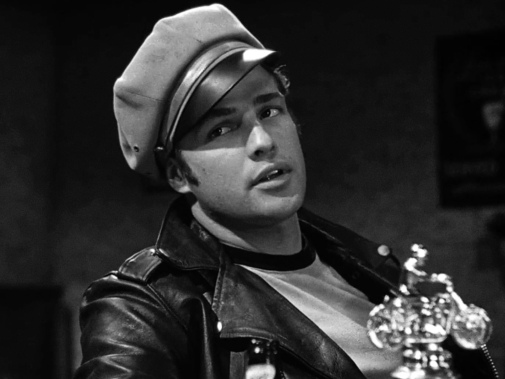
Today marks the Marlon Brando centennial, and what better way to celebrate than to explore the actor's filmography? In my case, I decided to plunge into one of those iconic pictures that, for some reason, had never crossed my path till today. It's 1953's The Wild One, the prototypical biker film from which many more sprung forth, a crystallization of midcentury rebellion as understood by Hollywood's paramount moralist, Stanley Kramer. He produced it as one of his social issue flicks, taking inspiration from a Harper's Magazine story that was, in itself, based on a series of events that took place in Hollister, California, 1947. Brando plays Johnny Strabler, leader of the Black Rebels Motorcycle Club…
"This is a shocking story. It could never take place in most American towns – but it did in this one. It is a public challenge not to let it happen again." – so starts The Wild One, as if to make sure we know what lesson to take from the ensuing picture. The gesture has Kramer's fingerprints all over it, as does the romantic narration that takes over the soundtrack almost as soon as Columbia's fanfare has done playing. However, before there's a single cut, a remarkable tension starts to emerge within the picture's very soul. As much as the text – written on-screen and spoken over it – might imply a repudiation of rebellion, the camera is besotted by the possibilities of such figures.
The narrative will follow that line of thought, beckoning sympathy through sentimentality and sentiment through Hollywood-style seduction. There's no greater weapon than star power or glamour, even when it dons a gritty getup. But there's a way to go before we get there.
Away from the manicured backlot – but still in Columbia property, of course – director László Benedek fixes his gaze on the empty road, which DP Hal Mohr renders as an array of near-abstract lines. The white stripe disappears into the horizon, perfectly drawn, straight and seemmingly contiguous with the asphalt borders, meeting far away. But over it, shadows darken the sun-blasted tar with organic shapes, irregularities that excite the eye and complicate the landscape's geometry. The sound of revving motors insinuates itself over Leith Stevens' score, and before you know it, a battalion of motorcycles slashes down the road, coming ever closer to the camera.
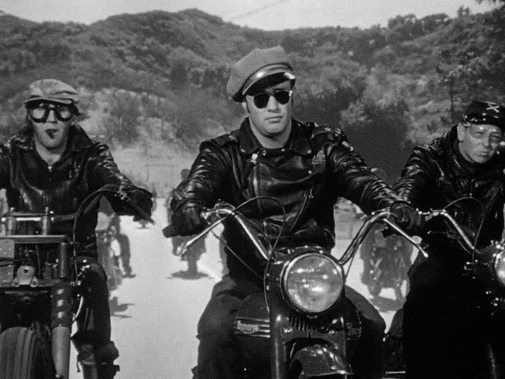
It's as simple as it is beautiful, a rhapsody of formal arrangements that use the impact of location photography for all it's worth. A cut to rear-projection medium dispels some of the mood, but what the frame loses in material authenticity, it gains in that aforementioned star power. Clad in leathers and tight jeans, Marlon Brando is a Tom of Finland illustration come to life, atop a motorcycle he rides with an attitude reminiscent of a noble knight but also sexual. His pouting lips add to the effect, giving more dimension to what could have been a piece of flat intimidation, machismo on wheels.
His presence is incandescent. It burns with a kiss you yearn for, even as you know it might destroy you. If not the kiss, it'll be the people's reaction to what he stands or doesn't stand for.
The club is headed to Carbonville, where a grand motorcycle race is on the way. Always looking for trouble, the leather-clad youths don't take any time before making a nuisance of themselves, even stealing the second-place trophy to adorn their leader's ride. They're soon sent away by the authorities and take refuge in the nearby town of Wrightsville, taking over the place to the uneasy compliance of residents and business owners. An accident causes discord and prolongs their stay while setting the stage for a love story between Johnny and Kathie, the chief of police's daughter who spends her days tending to the local bar. But the longer they remain, the longer their lives are at risk, regardless of whatever amorous entanglements form.
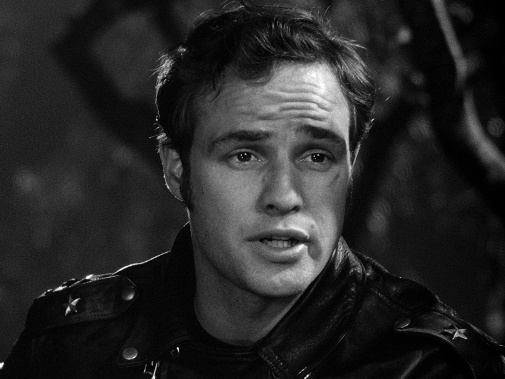
In the leading lady role, Mary Murphy isn't outstanding, but the camera loves her doll-like eyes, and she's a good focus for Brando's barrage of charged looks and amorous vulnerability. In scenes shared between the two, Benedek recognizes the performative nature of his hero's peacocking routine, framing his star in ways that consolidate his iconography as a king of cool but leave space for a softer side, hidden barely beneath the surface. I'm not used to thinking of Marlon Brando as an actor who shies away from overt demonstrativeness, but there's some of that in his portrayal of Johnny. Perchance is how much he expresses in quiet poses, his costume speaking louder than any actorly tic.
The camera, too, is eager to exploit him like a Greta Garbo full of testosterone, a statuesque canvas upon which one can project a galaxy of meaning. Think of the ending of Queen Christina with more petrol and tire tracks. In a sequence of mob justice turned into frenzied beating, Johnny is attacked in close quarters. Instead of staging the action for distant perusal, Benedek gets close and personal, hand-held and frantic. Brando never overplays the pain, preferring to act dazed, confused, alienated from his own body in an instant of panic. It's a tough act, for sure, though there's more to it than masculine expectations.
Johnny is so passive, martyrized, that you suddenly think Brando is embodying a religious effigy rather than a rebel without a cause. He is the ultimate victim of the intolerant, those who won't stand for anyone who doesn't adhere to the status quo and fall into a pack mentality much more brutal than anything their enemies might do. But he's also created to be a picture of implied aggression. No wonder so many identified with him – in Brando's hands and this fantastic lensing, Johnny can be the best and worst of people, the primal and the holy. Brando himself related to the character, his anti-authority attitude and boundless freedom.
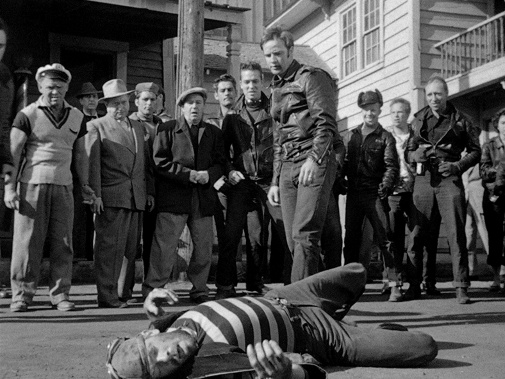
Or perhaps the key to understanding Brando's mysterious quality lies in the contrasting forces sharing the screen with his Johnny. Most other cast members shoot the slang – once provocative, now hopelessly quaint – in a declamatory manner that suggests students putting on an amateur show. Then there are the veterans, like an effectively weary Robert Keith, all old school technique adapted to a register reaching for rawness. Finally, Lee Marvin is a gas explosion within The Wild One's mechanism, biting into the role of a fellow gang leader with such fervor he seems capable of chewing the scenery even when standing still in the background.
Whatever the case, one thing remains true and indisputable. In The Wild One, Marlon Brando is more alluring than should be possible, the perfect converging of someone you want and want to be. Indeed, he was so magnetic that censorship agencies worldwide balked at what the movie could do to impressionable youths. Even within the US, Columbia faced trouble distributing the thing. Its star probably shared some of that alarm, having said it was too violent when recounting his difficulty seeing the movie once filming was over. Despite such issues, The Wild One survived the test of time, it lived on to influence culture and redefine how we imagine the 1950s, especially the then-nascent youth culture.
Though not as prestigious or historically important as A Streetcar Named Desire or The Godfather, The Wild One stands tall as an essential landmark for Marlon Brando, his Hollywood stardom and cultural impact. Honestly, I don't know why I waited so long before seeing it.
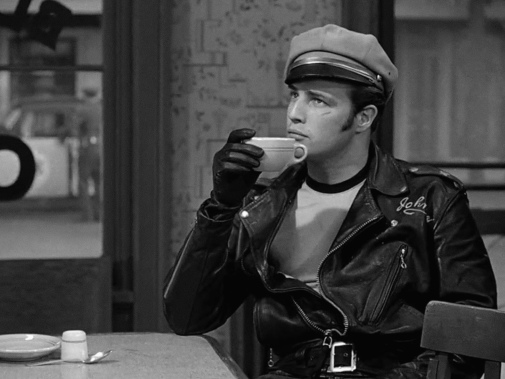
The Wild One is currently streaming on Tubi and Pluto TV. You can also rent and purchase it on the major platforms.



Reader Comments (3)
ohh, I like it!
.
Now that is the embodiment of cool.